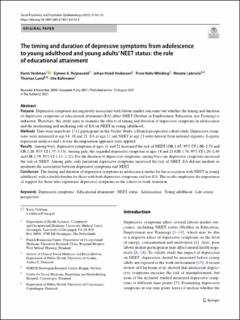| dc.contributor.author | Veldman, Karin | |
| dc.contributor.author | Reijneveld, Sijmen A. | |
| dc.contributor.author | Hviid Andersen, Johan | |
| dc.contributor.author | Nøhr Winding, Trine | |
| dc.contributor.author | Labriola, Merete | |
| dc.contributor.author | Lund, Thomas | |
| dc.contributor.author | Bültmann, Ute | |
| dc.date.accessioned | 2022-06-03T09:27:46Z | |
| dc.date.available | 2022-06-03T09:27:46Z | |
| dc.date.created | 2022-05-05T15:03:05Z | |
| dc.date.issued | 2022 | |
| dc.identifier.citation | Social Psychiatry and Psychiatric Epidemiology. 2022, 57 (1), 83-93. | en_US |
| dc.identifier.issn | 0933-7954 | |
| dc.identifier.uri | https://hdl.handle.net/11250/2997476 | |
| dc.description.abstract | Purpose Depressive symptoms are negatively associated with labour market outcomes but whether the timing and duration of depressive symptoms or educational attainment (EA) affect NEET (Neither in Employment, Education, nor Training) is unknown. Therefore, this study aims to examine the effects of timing and duration of depressive symptoms in adolescence and the moderating and mediating role of EA on NEET in young adulthood. Methods Data were used from 1512 participants in the Vestliv Study, a Danish prospective cohort study. Depressive symptoms were measured at age 14, 18 and 21. EA at age 21 and NEET at age 23 were derived from national registers. Logistic regression analyses and a 4-way decomposition approach were applied. Results Among boys, depressive symptoms at ages 14 and 21 increased the risk of NEET (OR 1.65, 95% CI 1.00–2.74 and OR 2.20, 95% CI 1.37–3.53). Among girls, this regarded depressive symptoms at ages 18 and 21 (OR 1.76, 95% CI 1.26–2.46 and OR 1.59, 95% CI 1.13–2.22). For the duration of depressive symptoms, among boys any depressive symptoms increased the risk of NEET. Among girls, only persistent depressive symptoms increased the risk of NEET. EA did not mediate or moderate the association between depressive symptoms and NEET. Conclusion The timing and duration of depressive symptoms in adolescence matter for the association with NEET in young adulthood, with a double burden for those with both depressive symptoms and low EA. The results emphasize the importance of support for those who experience depressive symptoms in the school-to-work transition. | en_US |
| dc.language.iso | eng | en_US |
| dc.rights | Navngivelse 4.0 Internasjonal | * |
| dc.rights.uri | http://creativecommons.org/licenses/by/4.0/deed.no | * |
| dc.title | The timing and duration of depressive symptoms from adolescence to young adulthood and young adults’ NEET status: the role of educational attainment | en_US |
| dc.title.alternative | The timing and duration of depressive symptoms from adolescence to young adulthood and young adults’ NEET status: the role of educational attainment | en_US |
| dc.type | Peer reviewed | en_US |
| dc.type | Journal article | en_US |
| dc.rights.holder | © The Author(s) 2021 | en_US |
| dc.description.version | publishedVersion | en_US |
| cristin.ispublished | true | |
| cristin.fulltext | original | |
| cristin.qualitycode | 1 | |
| dc.identifier.doi | 10.1007/s00127-021-02142-5 | |
| dc.identifier.cristin | 2021867 | |
| dc.source.journal | Social Psychiatry and Psychiatric Epidemiology | en_US |
| dc.source.volume | 57 | en_US |
| dc.source.issue | 1 | en_US |
| dc.source.pagenumber | 83-93 | en_US |

